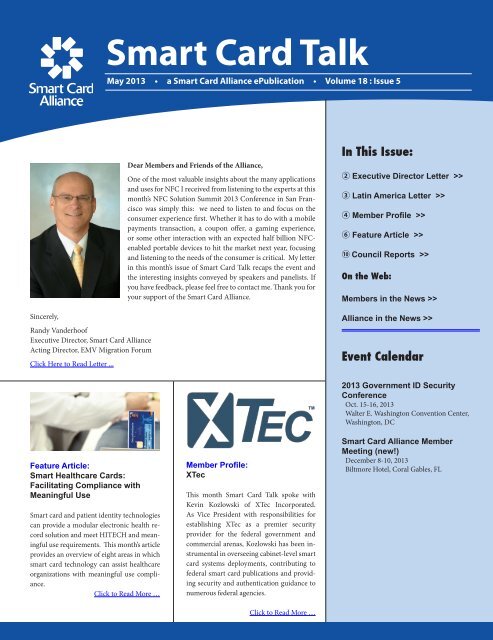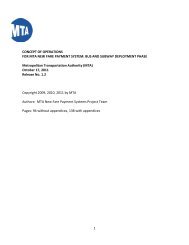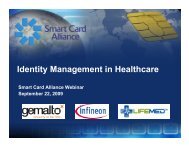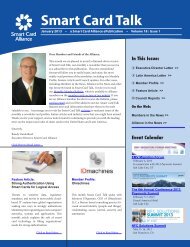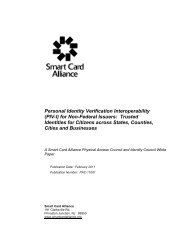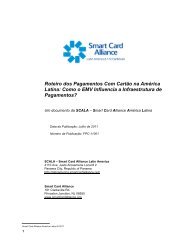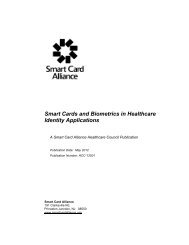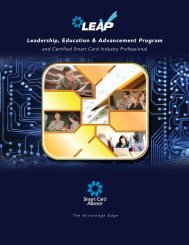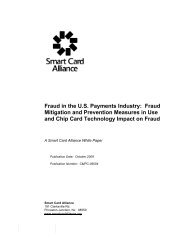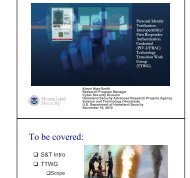Download PDF Version of the May Smart Card Talk.
Download PDF Version of the May Smart Card Talk.
Download PDF Version of the May Smart Card Talk.
- No tags were found...
You also want an ePaper? Increase the reach of your titles
YUMPU automatically turns print PDFs into web optimized ePapers that Google loves.
<strong>Smart</strong> <strong>Card</strong> <strong>Talk</strong><strong>May</strong> 2013 • a <strong>Smart</strong> <strong>Card</strong> Alliance ePublication • Volume 18 : Issue 5Sincerely,Randy Vanderho<strong>of</strong>Executive Director, <strong>Smart</strong> <strong>Card</strong> AllianceActing Director, EMV Migration ForumClick Here to Read Letter ...Dear Members and Friends <strong>of</strong> <strong>the</strong> Alliance,One <strong>of</strong> <strong>the</strong> most valuable insights about <strong>the</strong> many applicationsand uses for NFC I received from listening to <strong>the</strong> experts at thismonth’s NFC Solution Summit 2013 Conference in San Franciscowas simply this: we need to listen to and focus on <strong>the</strong>consumer experience first. Whe<strong>the</strong>r it has to do with a mobilepayments transaction, a coupon <strong>of</strong>fer, a gaming experience,or some o<strong>the</strong>r interaction with an expected half billion NFCenabledportable devices to hit <strong>the</strong> market next year, focusingand listening to <strong>the</strong> needs <strong>of</strong> <strong>the</strong> consumer is critical. My letterin this month’s issue <strong>of</strong> <strong>Smart</strong> <strong>Card</strong> <strong>Talk</strong> recaps <strong>the</strong> event and<strong>the</strong> interesting insights conveyed by speakers and panelists. Ifyou have feedback, please feel free to contact me. Thank you foryour support <strong>of</strong> <strong>the</strong> <strong>Smart</strong> <strong>Card</strong> Alliance.In This Issue:2 Executive Director Letter >>3 Latin America Letter >>4 Member Pr<strong>of</strong>ile >>6 Feature Article >>10 Council Reports >>On <strong>the</strong> Web:Members in <strong>the</strong> News >>Alliance in <strong>the</strong> News >>Event CalendarFeature Article:<strong>Smart</strong> Healthcare <strong>Card</strong>s:Facilitating Compliance withMeaningful Use<strong>Smart</strong> card and patient identity technologiescan provide a modular electronic health recordsolution and meet HITECH and meaningfuluse requirements. This month’s articleprovides an overview <strong>of</strong> eight areas in whichsmart card technology can assist healthcareorganizations with meaningful use compliance.Click to Read More …Member Pr<strong>of</strong>ile:XTecThis month <strong>Smart</strong> <strong>Card</strong> <strong>Talk</strong> spoke withKevin Kozlowski <strong>of</strong> XTec Incorporated.As Vice President with responsibilities forestablishing XTec as a premier securityprovider for <strong>the</strong> federal government andcommercial arenas, Kozlowski has been instrumentalin overseeing cabinet-level smartcard systems deployments, contributing t<strong>of</strong>ederal smart card publications and providingsecurity and au<strong>the</strong>ntication guidance tonumerous federal agencies.Click to Read More …2013 Government ID SecurityConferenceOct. 15-16, 2013Walter E. Washington Convention Center,Washington, DC<strong>Smart</strong> <strong>Card</strong> Alliance MemberMeeting (new!)December 8-10, 2013Biltmore Hotel, Coral Gables, FL
member pr<strong>of</strong>ileThis month <strong>Smart</strong> <strong>Card</strong><strong>Talk</strong> spoke with KevinKozlowski <strong>of</strong> XTec Incorporated.As Vice Presidentwith responsibilitiesfor establishing XTec as apremier security providerfor <strong>the</strong> federal governmentand commercialarenas, Kozlowski hasbeen instrumental inoverseeing cabinet-levelsmart card systems deployments,contributingto federal smart card publications and providing securityand au<strong>the</strong>ntication guidance to numerous federal agencies. Amember <strong>of</strong> <strong>the</strong> <strong>Smart</strong> <strong>Card</strong> Alliance Access Control Council,he has more than 20 years <strong>of</strong> experience in <strong>the</strong> informationtechnology industry, as well as a wide range <strong>of</strong> experiencein sales, marketing, engineering, and business leadership.Prior to joining XTec, Kozlowski was a Senior Manager withNorthrop Grumman Information Technology, where he providedoversight and management <strong>of</strong> <strong>the</strong> combined Logiconand Litton-PRC smart card practice. Kozlowski holds a Bachelor’sdegree in Finance and Economics from James MadisonUniversity and is a Certified <strong>Smart</strong> <strong>Card</strong> Industry Pr<strong>of</strong>essionalin Government (CSCIP/G).1. What is XTec’s main business pr<strong>of</strong>ile and<strong>of</strong>ferings?At XTec, our focus is au<strong>the</strong>ntication – strong, cryptographic au<strong>the</strong>ntication.It’s essential for securing facilities and data andessential for fighting fraud. Everything else is peripheral. Oursolutions support rapid, electronic au<strong>the</strong>ntication, which detersfraudulent credentials and allows organizations to maintain <strong>the</strong>tempo <strong>of</strong> regular operations.Au<strong>the</strong>ntication differentiates our Au<strong>the</strong>ntX products and services,which provide identity management capabilities and accesscontrol for an array <strong>of</strong> government customers. In fact, we are one<strong>of</strong> <strong>the</strong> largest HSPD-12 infrastructure providers in <strong>the</strong> U.S. government;XTec supports more than 70 federal agencies.Our solutions also reach beyond <strong>the</strong> federal arena. State and localgovernments, <strong>the</strong> financial industry, and <strong>the</strong> health care industrynow look to XTec to help <strong>the</strong>m achieve interoperability and combatfraud.2. What role does smart card technology play inyour business?For <strong>the</strong> past several years, XTec and <strong>the</strong> larger smart card markethave grown in tandem. And while we both pre-date HSPD-12, wehave been similarly energized by <strong>the</strong> directive. That’s because itarticulates a clear, post-September 11 conclusion about security inAmerica and America’s government: sound, interoperable credentialingis essential, and <strong>the</strong> smart card is our best bet.Granted, many competitors and colleagues in <strong>the</strong> industry cantrack <strong>the</strong>ir growth to <strong>the</strong> expansion <strong>of</strong> smart card use after HSPD-12’s issuance. XTec is not unique in that respect. What is unique,however, is XTec’s dynamic combination <strong>of</strong> smart card technologyand au<strong>the</strong>ntication. For XTec, smart cards provide <strong>the</strong> idealvehicle for quickly conducting electronic au<strong>the</strong>ntication for accessto a facility or application. For that very reason, we engineered oursolutions based upon smart card use and for cryptographic operations.The smart-card based design also <strong>of</strong>fers assurance to our customers.We didn’t contort our solutions to meet HSPD-12; <strong>the</strong> twowere compatible from <strong>the</strong> start, largely because <strong>of</strong> <strong>the</strong>ir incorporation<strong>of</strong> smart card technology. And as a result, we do not struggleto adapt to new standards. Our technology evolves seamlesslyalong with <strong>the</strong> smart card industry itself and with <strong>the</strong> changingstandards that shape it. Our customers can depend on that.3. What trends do you see developing in yourmarket?We see two main trends taking shape: <strong>the</strong> demand for PIV-I andgrowing interest in cloud-based solutions.4 <strong>Smart</strong> <strong>Card</strong> <strong>Talk</strong>
PIV-I - After completing <strong>the</strong> PIV-I certification process, we knew<strong>the</strong> technology had significant potential. But last year alone, wesaw interest in PIV-I capabilities explode. Many companies andnon-federal governments are lured by proven, open-standards PIVtechnology. And I think <strong>the</strong> primary reason is security. These areenterprises that understand more every day: “Hey, <strong>the</strong> old username-passwordmethod just isn’t viable in today’s world.” Theywant high-assurance credentials.Some want to interoperate with <strong>the</strong> federal government, but o<strong>the</strong>rs– such as those in <strong>the</strong> health care and financial services sectors– simply want technology that <strong>of</strong>fers federal governmentlevels<strong>of</strong> security. And PIV-I is where <strong>the</strong>se needs intersect.Cloud - More customers are expressing interest in <strong>the</strong> benefits<strong>of</strong> cloud applications and infrastructure. They want <strong>the</strong> cost savings,and <strong>the</strong>y like <strong>the</strong> idea <strong>of</strong> <strong>of</strong>floading responsibility for servermaintenance. We support those goals; having a secure, hosted infrastructureis more efficient, cost-effective, and reliable. We justremind <strong>the</strong>se customers that au<strong>the</strong>ntication should remain a corepart <strong>of</strong> <strong>the</strong>ir access control process, regardless <strong>of</strong> where it’s hosted.After all, reducing costs at <strong>the</strong> expense <strong>of</strong> security is not a trade-<strong>of</strong>fwe or our customers are willing to make.4. What do you see are <strong>the</strong> key factors drivingsmart card technology in government andcommercial markets in <strong>the</strong> U.S.?The very nature <strong>of</strong> electronic transactions will shape smart cardtechnology in today’s markets. What I mean is this: with electronictransactions you see a competition between <strong>the</strong> advances our technology<strong>of</strong>fers and <strong>the</strong> savvy <strong>of</strong> those who want to undermine orharness that technology for <strong>the</strong>ir gain. We see this everywheretoday – whe<strong>the</strong>r you yourself have been a victim <strong>of</strong> identity <strong>the</strong>ftor an unauthorized person has penetrated a government applicationor a critical infrastructure component. It’s widespread. And<strong>the</strong> solutions we develop must be stronger than <strong>the</strong> abilities <strong>of</strong> <strong>the</strong>criminals we face.We have several ways to approach <strong>the</strong>se problems; not all involvea smart card. But we must recognize that a username-passwordapproach isn’t viable, not with such high stakes. Because no matterhow much security you encase it with, a username-passwordcombination is a knowledge-based approach. It’s inherently vulnerable.5. What are some <strong>of</strong> <strong>the</strong> challenges you seeconfronting <strong>the</strong> smart card technology industry?Education on smart cards is our primary challenge as an industry.Within <strong>the</strong> federal government, most people understand at least<strong>the</strong> value <strong>of</strong> smart cards, even if <strong>the</strong>y don’t recognize <strong>the</strong> full range<strong>of</strong> capabilities. But beyond <strong>the</strong> federal government is an array <strong>of</strong>industries and local government entities that need <strong>the</strong> security thatsmart cards <strong>of</strong>fer. They just don’t know enough about it.I would say education efforts should focus on three key facts: First,smart card technology is privacy enhancing; it is intertwined withan existing trust infrastructure. Second, it can be user friendly aswell as mobile. Implementation and use are not onerous processes.Third, when implemented as an enterprise solution, smart cardtechnology <strong>of</strong>fers a notable return on investment.If more non-federal enterprises knew <strong>the</strong>se facts, I think adoption<strong>of</strong> smart card technology would be even more widespread.6. What type <strong>of</strong> measurable impact has <strong>the</strong> <strong>Smart</strong><strong>Card</strong> Alliance and/or Councils made in yourcompany’s business?The <strong>Smart</strong> <strong>Card</strong> Alliance has been an invaluable resource for industrycollaboration. Although <strong>the</strong> smart card market is biggerthan ever, it still maintains a niche feel. That common bond <strong>of</strong>specializing in a targeted technology unites <strong>Smart</strong> <strong>Card</strong> Alliancemember companies and allows <strong>the</strong> group to remain focused andto continue providing value to its members.The Alliance is also a significant source <strong>of</strong> employee education forXTec. More than 40% <strong>of</strong> our employees have completed <strong>the</strong> LEAPCertified <strong>Smart</strong> <strong>Card</strong> Industry Pr<strong>of</strong>essional (CSCIP) program. Wefind that proven, measurable competence in our field is compellingfor both current and potential customers.Member Point <strong>of</strong> Contact:Kevin KozlowskiVice President, XTec Incorporated, www.xtec.comkkozlowski@xtec.com(703) 547-3524<strong>Smart</strong> <strong>Card</strong> <strong>Talk</strong> 5
feature article<strong>Smart</strong> Healthcare <strong>Card</strong>s:Facilitating Compliance with Meaningful UseMeaningful use <strong>of</strong> health information technology is an umbrellaterm for rules and regulations with which hospitals and physiciansmust comply to qualify for federal incentive funding under <strong>the</strong>American Recovery and Reinvestment Act <strong>of</strong> 2009 (ARRA). [1]ARRA authorizes <strong>the</strong> Centers for Medicare and Medicaid Services(CMS) to provide reimbursement incentives for eligible pr<strong>of</strong>essionalsand hospitals that meet meaningful use criteria on <strong>the</strong> wayto becoming “meaningful users” <strong>of</strong> certified electronic health record(EHR) technology. Meaningful use includes using EHR technologyfor functions that both demonstrate and improve quality <strong>of</strong>care, such as e-prescribing, electronic exchange <strong>of</strong> health information,and submission <strong>of</strong> quality measures to CMS.Meaningful use sets healthcare goals, ra<strong>the</strong>r than goals for informationtechnology. The overall goals are to use EHR technologyfor <strong>the</strong> following:1. Improve quality, safety, and efficiency <strong>of</strong> patient care2. Engage patients and families3. Improve care coordination4. Ensure adequate privacy and security for personal healthinformation5. Improve population and public healthHospital LOGO & NamePatientSUSAN B JONES-SMITHConfidential Patient ID808400 123456 789012Provider (80840)1234 567 893DOB 11/14/1978Issued 5/14/10health information securely over <strong>the</strong> internet with <strong>the</strong>irfamilies.• The Stage 2 rules document includes:• Minor changes to Stage 1 criteria and measures• Additional requirements and measures for achieving Stage 2• Additional clinical quality measures• Additional reporting requirements and mechanismsImplementation <strong>of</strong> meaningful use and incentive payment opportunitiesextends until at least 2020, with incentives decreasing overtime to encourage early adoption <strong>of</strong> EHR technology.<strong>Smart</strong> cards can make critical information readily available tohealthcare providers and facilities, which positively affects <strong>the</strong>quality, accuracy, and cost <strong>of</strong> care. Current technology supportssmart card solutions that can integrate with current provider systemsusing <strong>the</strong> cloud and HL7 messaging. Health informationcan be exchanged among providers and across systems, makingkey health information mobile and facilitating coordination <strong>of</strong>care. This same technology also allows healthcare informationto be transformed into a standardized electronic format that canbe accessed by patients and <strong>the</strong>ir families through secure patientportals.Implementation <strong>of</strong> meaningful use is occurring in multiple stages.Stage 1 implementation requirements and measures are documentedin <strong>the</strong> Department <strong>of</strong> Health and Human Services FinalRule <strong>of</strong> July 28, 2010.The Department <strong>of</strong> Health and Human Services’ Office <strong>of</strong> <strong>the</strong> NationalCoordinator (ONC) states that EHRs provide <strong>the</strong> followingbenefits for providers and <strong>the</strong>ir patients: [2]• Complete and accurate health information.• Better access to health information.• EHRs facilitate access to <strong>the</strong> information that providers needto diagnose health problems earlier and improve <strong>the</strong> healthoutcomes <strong>of</strong> <strong>the</strong>ir patients. EHRs also allow information tobe shared more easily among doctors’ <strong>of</strong>fices and hospitalsand across healthcare systems, leading to better coordination<strong>of</strong> care.• Patient empowerment.• EHRs empower patients to take a more active role in <strong>the</strong>irhealth and in <strong>the</strong> health <strong>of</strong> <strong>the</strong>ir families. Patients can receiveelectronic copies <strong>of</strong> <strong>the</strong>ir medical records and share <strong>the</strong>ir<strong>Smart</strong> card and patient identity technologies can provide a modularEHR solution and meet Health Information Technology forEconomic and Clinical Health (HITECH) and meaningful use requirementsin eight areas:• Streamline patient registration and discharge• Fulfill government requirements for confirming identityverification• Increase patient privacy and security• Prevent record duplication• Provide consistent branding across an organization andbeyond• Serve as a real-time, portable mini-EHR• Provide first responders with potentially life-savinginformation• Satisfy HIPAA compliance requirementsStreamline registration and discharge. Use <strong>of</strong> a smart healthcarecard for registration or admission allows healthcare organizationsto decrease patient wait times, improve <strong>the</strong> quality <strong>of</strong> care, andheighten efficiency by confirming a patient’s identity, registering orchecking <strong>the</strong> patient in, and verifying insurance instantly. Because6 <strong>Smart</strong> <strong>Card</strong> <strong>Talk</strong>
<strong>the</strong> process does not rely on human data entry or transcription, errorscan be virtually eliminated. Use <strong>of</strong> a smart healthcare card atdischarge allows <strong>the</strong> system to recognize a patient’s identity, matchit to <strong>the</strong> visit, update <strong>the</strong> card with demographic and medical information,update a patient data portal with required discharge information(e.g., follow up appointments, medication information,education, instructions, activity requirements, dietary care), andtrigger transmission <strong>of</strong> any required educational materials to <strong>the</strong>patient’s e-mail address.Meet government identity verification requirements. <strong>Smart</strong>card technology is currently used for <strong>the</strong> Department <strong>of</strong> DefenseCommon Access <strong>Card</strong> (CAC), <strong>the</strong> Federal Information ProcessingStandard (FIPS) 201 Personal Identity Verification (PIV) card(issued to all Federal employees and subcontractors), <strong>the</strong> TransportationWorker Identification Credential (TWIC), and <strong>the</strong> U.S.electronic passport. Using standards such as FIPS 201, smart cardscan provide single sign-on solutions to EHRs for government-employedmedical personnel, such as physicians and nurses.Increase patient privacy and security. <strong>Smart</strong> card solutions canmeet or exceed all mandates and requirements for patient privacy,safety, records, system security, and confidentiality. All smart carddata can be encrypted, and all data transmitted can comply withapplicable standards (e.g., HL7, SnoMed, and ISO/IEC). Medicareand Medicaid data and statistics can be maintained per federal requirements.[3]<strong>Smart</strong> cards integrated with an identity s<strong>of</strong>twaresolution can also support automated time-based reporting andreview <strong>of</strong> patient data, protecting healthcare information with encryptionalgorithms that allow access only by authorized readers.<strong>Smart</strong> cards can support multi-factor au<strong>the</strong>ntication, which satisfiesrequirements such as those for e-prescribing, and can providestrong au<strong>the</strong>ntication, digital signatures, and security through encryption.Prevent record duplication. <strong>Smart</strong> cards can significantly decrease<strong>the</strong> incidence <strong>of</strong> duplicate records and <strong>the</strong> associated expense.Linking a patient to that patient’s health records seemsa simple process, but human error, such as transcription <strong>of</strong> <strong>the</strong>wrong medical record number, can retrieve an incorrect recordor cause creation <strong>of</strong> a duplicate record because <strong>the</strong> correct recordhas not been located. Using au<strong>the</strong>nticated identifiers on a cardcan match a patient to that patient’s individual medical record, improvingadministrative functions such as billing and registrationand enhancing continuity <strong>of</strong> care.Provide consistent branding.While smart cards can provide asingle tool for patient identitymanagement, <strong>the</strong>y also provide<strong>Smart</strong> <strong>Card</strong> <strong>Talk</strong> 7
healthcare organizations and affiliations with <strong>the</strong> opportunity tobuild stronger community alliances between healthcare organizations,integrated delivery networks, hospital systems, providernetworks, and auxiliary services. Coupled with identity s<strong>of</strong>tware,smart cards can replace multiple cards (e.g., insurance IDs, allergycards, registration cards) that a patient or consumer would o<strong>the</strong>rwisehave to carry to be known throughout <strong>the</strong> organization.In addition, <strong>the</strong>re are smart card solutions that make <strong>the</strong> patient’shealthcare provider <strong>of</strong> record immediately known and recognizedto o<strong>the</strong>r members <strong>of</strong> <strong>the</strong> healthcare community, such as pharmacies,durable equipment providers, and o<strong>the</strong>rs.Serve as a real-time EHR. <strong>Smart</strong> cards can contain encryptedpatient demographic information, such as name, date <strong>of</strong> birth,height, weight, and body mass index (BMI), as well as o<strong>the</strong>r keyinformation. In addition, a smart card can store key health datacomponents such as current medications, allergies, immunizations,a conditions or problem list, smoking status, surgeries, andhospitalizations. <strong>Smart</strong> cards can also be configured to store patientinformation such as implanted devices, artificial valves, defibrillators,advance directives, and organ donation status. Unlikestandard EHRs, a smart card is mobile and goes with <strong>the</strong> patient.Provide first responders with critical information. In an emergency,smart cards can enable first responders using a simpleportable reader to identify a patient immediately and access <strong>the</strong>patient’s medical record, regardless <strong>of</strong> whe<strong>the</strong>r <strong>the</strong> patient is conscious,is emotionally or physically able to convey <strong>the</strong> entire medicalpicture accurately, or has language barriers that impede effectivecommunication.Satisfy HIPAA compliance requirements. <strong>Smart</strong> healthcarecards <strong>of</strong>fer entities covered under HIPAA an effective tool to facilitatecompliance with <strong>the</strong> HIPAA Privacy Rule. One <strong>of</strong> <strong>the</strong> key provisions<strong>of</strong> <strong>the</strong> HIPAA Privacy Rule is to assure that an individual’shealth information is properly protected and that individuals cancontrol how <strong>the</strong>ir health information is accessed and used. Providinghealthcare organization employees as well as patients withsmart healthcare cards can help ensure that health informationis accessed only by those with <strong>the</strong> appropriate credentials. Manyrecent high-pr<strong>of</strong>ile breaches <strong>of</strong> protected health information occurbecause data is kept on unsecured, unencrypted devices suchas CDs and USB flash drives, or because entities have been ableto access medical records without proper authorization. A smar<strong>the</strong>althcare card can minimize or eliminate such breaches usingembedded secure chip technology, encryption, and o<strong>the</strong>r cryptographymeasures that make it extremely difficult for unauthorizedusers to access or use information on <strong>the</strong> smart card or to createduplicate cards. These capabilities help protect patients fromidentity <strong>the</strong>ft, protect healthcare institutions from medical fraud,and help healthcare providers meet HIPAA privacy and securityrequirements.8 <strong>Smart</strong> <strong>Card</strong> <strong>Talk</strong>In summary, smart healthcare cards can better position healthcareorganizations and providers for meaningful use <strong>of</strong> EHRs, while addressingmany <strong>of</strong> <strong>the</strong> security and privacy challenges that comewith EHRs and health data exchanges.References and Notes[1] Meaningful use is a broad topic. For more information,follow <strong>the</strong> links to “EHR Incentives” at The Centers forMedicare and Medicaid Services Web site: https://www.cms.gov. Dr. John Hamalka’s blog (http://geekdoctor.blogspot.com/2011/01/bookmarked-final-rules.html) contains bookmarkedversions <strong>of</strong> <strong>the</strong> CMS final rules. Additional resourcesare <strong>the</strong> Healthcare Information and Management Society(HIMMS), “Meaningful Use One Source,” http://www.himss.org/ASP/topics_meaningfuluse.asp.[2] “What Is Meaningful Use?,” HHS HealthIT.gov web site,http://healthit.hhs.gov/portal/server.pt/community/healthit_hhs_gov__meaningful_use_announcement/2996[3] http://www.cms.gov/Research-Statistics-Data-and-Systems/CMS-Information-Technology/InformationSecurity/Information-Security-Library.html. CMS has defined 11 informationtypes processed by CMS information systems. Foreach information type, CMS used FIPS 199 to determine anassociated security category. CMS also used OMB M-04-04to determine each information type’s e-Au<strong>the</strong>ntication assurancelevel.About this ArticleThis article is an extract from <strong>the</strong> <strong>Smart</strong> <strong>Card</strong> AllianceHealthcare Council publication, <strong>Smart</strong> <strong>Card</strong> Technologyin U.S. Healthcare: Frequently Asked Questions. The FAQwas developed to provide an easy-to-use resource for understandinghow smart card technology is used for healthcareapplications and for discussing <strong>the</strong> benefits that smar<strong>the</strong>althcare cards deliver to patients, healthcare providers andhealthcare payers. Healthcare Council members participatingin <strong>the</strong> development and review <strong>of</strong> <strong>the</strong> FAQ included: ABnoteGroup; CSC; Datacard Group; Eid Passport; Gemalto;LifeMed ID, Inc.; Oberthur Technologies; OTI America; RMIndustries; SafeNet Inc.; SecureKey Technologies; WatchdataTechnologies USA; XTec, Inc.About <strong>the</strong> <strong>Smart</strong> <strong>Card</strong> Alliance HealthcareCouncilThe <strong>Smart</strong> <strong>Card</strong> Alliance Healthcare Council brings toge<strong>the</strong>rpayers, providers, and technologists to promote <strong>the</strong> adoption<strong>of</strong> smart cards in U.S. healthcare organizations. The HealthcareCouncil provides a forum where all stakeholders cancollaborate to educate <strong>the</strong> market on <strong>the</strong> how smart cardscan be used and to work on issues inhibiting <strong>the</strong> industry.
Welcome New Members• Hillsborough Transit Authority, Government• ImageWare Systems, Inc., General Member• Intelligent Parking Concepts LLC, Associate Member• IPS Group, Inc., General Member• STMicroelectronics Ltda., SCALA, GovernmentNew CSCIP Recipients• Jamie Chang, Deloitte & Touche LLP• Vamsi K. BondadaVenkata, Deloitte & Touche LLP• Brenda Sutton, Deloitte & Touche LLP• John Ward, Deloitte & Touche LLPFor more news, visit our website at www.smartcardalliance.org.Members can also access white papers, educational resources and o<strong>the</strong>r content.from <strong>the</strong> alliance <strong>of</strong>fice191 Clarksville RoadPrinceton Junction, New Jersey 085501.800.556.6828Fax: 1.609.799.7032info@smartcardalliance.orgwww.smartcardalliance.orgAbout <strong>Smart</strong> <strong>Card</strong> <strong>Talk</strong><strong>Smart</strong> <strong>Card</strong> <strong>Talk</strong> is <strong>the</strong> monthly e-newsletterpublished by <strong>the</strong> <strong>Smart</strong> <strong>Card</strong> Allianceto report on industry news, informationand events and to provide highlights <strong>of</strong> Allianceactivities and membership.About <strong>the</strong> <strong>Smart</strong> <strong>Card</strong> AllianceThe <strong>Smart</strong> <strong>Card</strong> Alliance is a not-for-pr<strong>of</strong>it,multi-industry association working tostimulate <strong>the</strong> understanding, adoption, useand widespread application <strong>of</strong> smart cardtechnology.<strong>Smart</strong> <strong>Card</strong> <strong>Talk</strong> 9
council reportsUpdates from <strong>the</strong> Alliance Industry CouncilsAccess Control• The Access Control Council is working on a projectto provide comments to <strong>the</strong> U.S. Coast Guard on <strong>the</strong>Transportation Working Identification Credential ReaderRequirements Notice <strong>of</strong> Proposed Rulemaking (NPRM).• The Council is developing comments to submit to NIST on<strong>the</strong> draft Special Publication (SP) 800-73-4, Interfaces forPersonal Identity Verification.Healthcare• The Healthcare Council is collaborating with <strong>the</strong> Workgroupfor Electronic Data Interchange (WEDI) Health ID <strong>Card</strong> Subworkgroupto provide input on smart cards and biometricsfor a WEDI research paper.• The Council is developing comments to respond to <strong>the</strong> Senaterequest for feedback on federal progress promoting healthinformation technology adoption and standardsIdentity• The Identity Council is developing a white paper on smartcard technology and NSTIC. The goal <strong>of</strong> <strong>the</strong> white paper isto raise awareness <strong>of</strong> <strong>the</strong> benefits <strong>of</strong> smart card technologyand show how smart card technology can be used for highassurance credentials in <strong>the</strong> NSTIC identity ecosystem.• The Council is completing a cross-council white paper projecton supporting <strong>the</strong> PIV application on mobile devices with <strong>the</strong>UICC.Mobile and NFC• The Mobile and NFC Council held two successful webinarsto complete <strong>the</strong> series on mobile/NFC security fundamentals.The third webinar, “NFC Forum Tags and SecurityConsiderations,” was held on April 18 th , with presentationsfrom Tony Rosati (NFC Forum Security Work Group &Blackberry), Joe Tassone (Identive), Mike Zercher (NXPSemiconductors), and Rob Zivney (Identification TechnologyPartners). The fourth webinar, “NFC Application UseCases: Security Considerations,” was held on <strong>May</strong> 9 th andfeatured presentations from Tony Sabetti (Isis), ChristianAli (SecureKey Technologies), Jonathan Main (NFC Forum/Master<strong>Card</strong>), and Steve Rogers (IQ Devices). Webinarrecordings are available at http://www.smartcardalliance.org/pages/activities-events-mobile-nfc-security-fundamentals.10 <strong>Smart</strong> <strong>Card</strong> <strong>Talk</strong>
• The Mobile and NFC Council held a well-attended in-personmeeting at <strong>the</strong> 2013 NFC Solutions Summit on <strong>May</strong> 15 th . Themeeting focused on <strong>the</strong> secure credentials on mobile deviceswhite paper use cases, with presentations from <strong>the</strong> memberteams on <strong>the</strong> progress <strong>of</strong> <strong>the</strong>ir content.• A <strong>Smart</strong> <strong>Card</strong> Alliance workshop, “NFC Base Camp: TheFundamentals <strong>of</strong> NFC Mobile Technology and BusinessApplications,” was held at <strong>the</strong> NFC Solutions Summit on<strong>May</strong> 14, 2013, in Burlingame, CA. Speakers included: Jean-Luc Azou (HID Global); Lanny Byers (Consult Hyperion);Mukesh Chandek (Gemalto); David deKozan (Cubic); ChrisEdwards (Intercede); Jeff Fonseca (NXP Semiconductors);Howard Hall (Consult Hyperion); Reid Holmes (INSIDESecure); Roger Hornstra (Identive); Tony Sabetti (Isis);Bart van Hoek (UL); Tom Zalewski (CorFire); Rob Zivney(Identification Technology Partners).Payments• The Payments Council is starting two new projects: a whitepaper on EMV and card-not-present fraud and a white paperon <strong>the</strong> U.S. payments landscape.• The Council held an in-person meeting at <strong>the</strong> 2013 NFCSolutions Summit on <strong>May</strong> 15 th , discussing status <strong>of</strong> Councilprojects.Transportation• The Transportation Council completed an election for <strong>the</strong>parking vice chair; Steven Grant (LTK Engineering Services)has been elected. In addition, Eric Schindewolf (Visa) hasjoined <strong>the</strong> Council Steering Committee.• The Council is starting a new white paper project on <strong>the</strong> EMVimpact on transit.O<strong>the</strong>r Council Information• Members-only council web pages are available at http://www.smartcardalliance.org/councils. These are passwordprotectedpages that contain council working and backgrounddocuments and contact lists. Each Council area has aseparate password since Councils may have differentmembership policies. If you are a <strong>Smart</strong> <strong>Card</strong> Alliancemember and would like access to a council site, please contactCathy Medich.• A Council meeting calendar is available on <strong>the</strong> members-onlyweb site at http://www.smartcardalliance.org/pages/memberscouncil-resources.• If you are interested in forming or participating in an Alliancecouncil, contact Cathy Medich.Alliance Members: Participation in all currentcouncils is open to any <strong>Smart</strong> <strong>Card</strong> Alliance memberwho wishes to contribute to <strong>the</strong> council projects. Ifyou are interested in participating in any <strong>of</strong> <strong>the</strong> activecouncils, please contact Cathy Medich.<strong>Smart</strong> <strong>Card</strong> <strong>Talk</strong> 11


